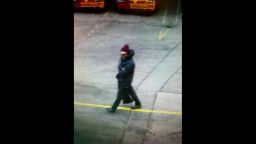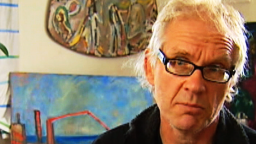Story highlights
Cartoonist on al Qaeda's "Most Wanted" list was at Copenhagen event that was site of first shooting
Danish police say gunman carjacked a civilian's car after first shooting, then abandoned it
[Breaking news update at 1:17 a.m. ET]
Danish police shot and killed a man early Sunday after he fired at them in the capital of Copenhagen, a journalist for TV2 reported Sunday.
Police said the man’s address was under observation and are investigating whether he was linked to earlier attacks, according to journalist Astrid Sondberg.
No officers were injured in the shootout.
[Previous story, published at 10:51 p.m. ET]
(CNN) – Police in the Danish capital of Copenhagen were stopping cars and cordoning off sections of the city Sunday morning after two shootings within hours of each other left two people dead and five wounded.
It was unclear whether the shootings were connected, police said. No one has been arrested and police are working as if there might be more than one gunman.
Officers were searching taxis and private cars, having the drivers open their vehicle trunks as the city was on high alert, Astrid Sondberg, a reporter for TV2 in Denmark, reported.
A police spokesman said there is no ban on civilians moving around, but they should respect police roadblocks.
The second incident took place about 10 hours after a deadly terror attack. In the latest incident, shots were fired near a synagogue when a person approached two police officers and began shooting.
Another person was shot and later died, and the police officers were wounded – one in an arm, the other in a leg, police said. Their injuries weren’t life-threatening.
Police earlier said the gunman ran from the scene. The shooter was a man dressed in a light gray jacket, black pants and black shoes. The jacket was different from the one believed to have worn by a possible suspect in the first shooting.
Earlier, a gunman stormed a cafe where controversial cartoonist Lars Vilks and his supporters had gathered for a free speech forum, killing a man and wounding three police officers before fleeing, police said.
Helle Merete Brix – founder of the Lars Vilks Committee, created two years ago in support of the Swedish cartoonist whose portrayals of the Prophet Mohammed angered many in the Muslim world – told CNN that security personnel on site moved her and others to safe areas after shots rang out.
She and Vilks ended up in a storage room together, holding hands, until police told them it was OK to come out.
“We have never taken any chances,” Brix said, referring to the heavy security from police, Danish intelligence services and Vilks’ own security guards at this and other committee events. “What we have so much been frightened would happen happened.”
Why Islam forbids images of Mohammed
After the attack, what appeared to be the man, dressed in dark clothes, carjacked a civilian’s dark Volkswagen Polo and drove away, Danish police said. That vehicle was found between two train stations.

The gunman remained at large Saturday night. Police initially had said there were two shooters in the first incident. The discrepancy was caused by chaos in the aftermath of the incident, Copenhagen police spokesman Steen Hansen said.
The 55-year-old man who was killed hasn’t been identified. Nor have authorities identified the three wounded law enforcement officers – two with Danish intelligence and one police officer – though investigator Joergen Skov did say none of them suffered serious injuries.
Given Islamist extremists’ documented threats against Vilks and their willingness to act on similar threats – as proven last month in France – Danish Prime Minister Helle Thorning-Schmidt said, “Everything points to … the shooting in Oesterbro (being) a political assassination and therefore a terror attack.”
Thorning-Schmidt vowed that “all resources will be used to find (those responsible) and bring them before a judge” for an attack she said filled her “with deep anger.”
“We have some difficult days ahead,” the Prime Minister said. “… But in Denmark, we will never bow to violence.”
‘We were just hiding … and hoping for the best’
About 30 people – including Vilks and French Ambassador to Denmark Francois Zimeray, who tweeted later that he is “still alive in the room” – went through airport-level security to get into Saturday’s event at the building located in what Brix described as a “very peaceful area” of the Danish capital.
But it didn’t last long, with noise erupting just a few minutes in.
Dennis Meyhoff Brink, a satire researcher and Danish university professor, said he heard about 30 shots at about 3:30 p.m. (9:30 a.m. ET), as well as someone yelling in a foreign language.
“Everybody, of course, panicked in the room and tried to run,” Brink told CNN. “… We were just hiding … and hoping for the best.”
The attacker made it just inside the building but apparently got no farther, said Brix, a journalist and literary critic. She recalled how one man there “acted very quickly and courageously” by pushing a woman down to the ground, then putting himself on top of her so she wouldn’t get shot.
Bodyguards returned fire, the Copenhagen police official said.
At one point, two people came running into the meeting room – one of them bleeding from the leg, after having apparently been shot – to “tell us to calm down,” Brink said.
Sirens could be heard 10 to 15 minutes after the shots, at which point Brink said “we started to feel more safe.” The discussion on free speech even resumed, though eventually all those at the event were bused to a local police station.
Copenhagen police later tweeted a picture of the suspect, covered up and dressed in dark clothes, wanted in connection with the attack.
“We are investigating this as a terror attack,” said Skov, the police official, noting that authorities are taking into account that both the French ambassador and Vilks attended Saturday’s event. “There is an extremely large presence of police in Copenhagen right now.”
Target since cartoon of Mohammed with dog’s body
Danes in Copenhagen and beyond quickly got support from around the world, including from the mayor of Paris – who just more than a month ago lived this same nightmare during the massacre at the offices of satirical magazine Charlie Hebdo in her city.
“In the name of Parisians,” Mayor Anne Hidalgo tweeted, “I express my full support.”
Like Charlie Hebdo editor Stephane “Charb” Charbonnier, Vilks was one of nine faces on a “Most Wanted” graphic published by al Qaeda’s Inspire magazine for “crimes against Islam.” Others include a pair of Danish journalists who published 12 cartoons depicting Mohammed in the Jyllands-Posten newspaper; Florida pastor Terry Jones, who burned a Quran; and “Satanic Verses” author Salman Rushdie.

Because of that, Brix said, “there’s no doubt” the Copenhagen event was targeted because of Vilks, who has “not been able to live a normal life” for years, according to the committee.
“This is … why we set up the committee: to support Mr. Vilks and support his right to freedom of speech,” Brix said.
Vilks became a target after his 2007 cartoon depicting Mohammed with the body of a dog – an animal that conservative Muslims consider unclean.
In a CNN interview later that year from his home in rural Sweden, Vilks said the drawing was calculated to elicit a reaction.
“It should be possible to insult all religions in a democratic way,” he said then. “If you insult one (religion), then you should insult the other ones.”
CNN’s Susanne Gargiulo reported from Copenhagen. CNN’s Greg Botelho and Steve Almasy wrote from Atlanta. CNN’s Kim Norgaard, Margot Haddad, Pierre Meilhan, Paul P. Murphy and Lucy Pawle contributed to this report.

















